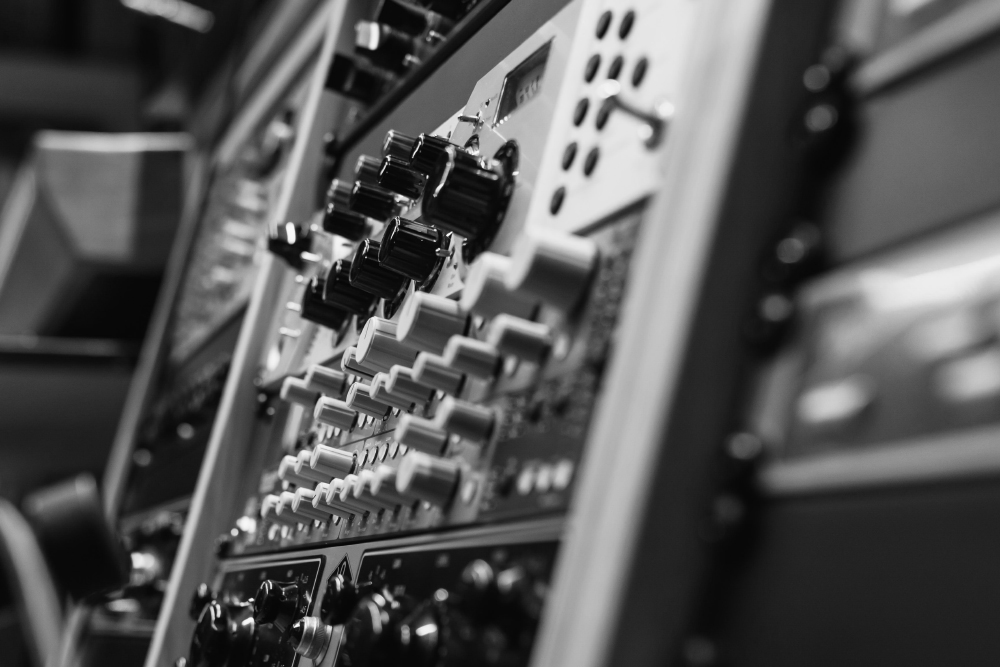
Compressing the stereo bus during mixdown before the 2 -track is a popular effect, particularly on technique consoles that feature an onboard stereo program compressor.
This technique can smooth out the entire mix, but may prove unnecessary when various tracks requiring compression within the mix have already been processed. (The net result of this trick is to simulate the heavy compression that occurs prior to the signal reaching an AM or FM transmitter, thereby giving a single or album mix the same sound whether it is played over the air or on a home stereo system. Such processing has serious implications, however, since it can take the life out of the mix by inhibiting the song’s dynamics.)
The advent of Compact Disc and digital multitracks in the studio is changing the way we approach recording, and the way in which compressors are being used. With digital’s greater dynamic range and absence of tape hiss, packing the tape for maximum level is no longer a major priority. Because the 16-bit binary code does not recognize tape noise like analog tape, lower levels can be recorded without sacrificing signal-to-noise gains.
In the digital domain, however, a new reason for compression or peak limiting exists, because digital recorders are totally unforgiving when the bit ceiling has been reached -unmistakable distortion and clipping will result. Because the digital domain does offer greater dynamic range, mixdown compression may still be desirable for sound placement within the stereo mix. Using compressors for creative sound, processing will be appropriate for achieving effects that have become popular.
As a recording engineer, I have found that care and taste must be exercised when using these compression techniques, simply because they do not apply to all musical styles and sounds. Compressor/limiters can have a great positive value, but may also have a negative impact on audio fidelity, transparency and transient response, making some material sound too clean, controlled and static.
Compression should be used appropriately to achieve specific sound goals, not as matter-of-fact processing.
What is Gain Reduction?
There are many misnomers and misunderstandings about how compressors and limiters function. In an attempt to shed some light on their mode of operation and the different types of gain reduction control, RE /P offers the following definitions:
Leveling is usually taken to mean the long-term control of signal levels. The compression ratio is greater than 10:1, with slow attack and release times. As a result, leveling has negligible or no effect on short-term changes in the average level, or on sudden transients.
Compression is used to maintain a constant power level; in essence, it prevents levels from falling too low. Benefits include improved signal-to-noise ratio and correction of excessive volume level.
Limiting prevents a signal from exceeding a preset level and provides protection from overmodulation, overcutting and monitor damage, and elimination of transient peak levels. There are two basic types: program limiters (referring to the highest VU level occurring within source material); and peak limiters (regarding waveform peak amplitude, measured with a peak program meter or oscilloscope). When the waveform amplitude cannot be allowed to exceed a predetermined value, peak limiters are used. They are characterized by fast attack and release times, high compression ratios and high threshold levels.
The parameters that characterize limiters and compressors are as follows:
Compression ratio defines an input-level decibel change corresponding to a user-defined, output-level decibel change. Perfect linear circuits produce a 1:1 compression ratio; compressors and limiters use ratios or slopes that range from 1.1 :1 to 30:1. Variable-slope compressors begin with a low compression ratio, and then increase as the level of the input signal rises.
Threshold refers to user-definable, dynamic range modification. All limiters and most compressors operate below this threshold level as linear amplifiers, with a relative slope of 1:1. In order to be effective, limiters usually operate at a threshold above 0 VU.
Attack time is the time required by a device to bring an input signal under 90% control after it has exceeded a defined threshold. To prevent sudden signal increases from escaping amplitude control, limiters usually incorporate fast attack times. To prevent unwanted effects on transients, compressors use slower attack times.
Release time is the time required by a device to restore an input signal to 90% of full gain, after it has dropped below a defined threshold. While longer release times result in less apparent volume, faster release times can provide greater volume, but can also introduce more distortion into low-frequency program material.
RE/P Acknowledgement: Thanks to Joe Chicarelli, David Sherfey, Peter Chaiken and all the other engineers in the recording industry who may have invented many of the tricks we take for granted.
Denis Degher is a freelance engineer and a regular contributor to RE/P.
Editor’s Note: This is another in a growing a series of articles from Recording Engineer/Producer (RE/P) magazine, which began publishing in 1970 under the direction of Publisher/Editor Martin Gallay. After a great run, RE/P ceased publishing in the early 1990s, yet its content is still much revered in the professional audio community. RE/P also published the first issues of Live Sound International magazine as a quarterly supplement, beginning in the late 1980s, and LSI has grown to a monthly publication that continues to thrive to this day.
Our sincere thanks to Mark Gander of JBL Professional for his considerable support on this archive project.
